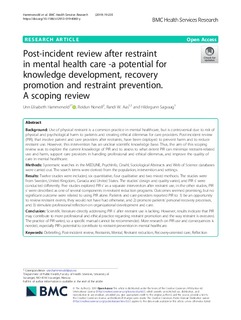| dc.contributor.author | Hammervold, Unn Elisabeth | |
| dc.contributor.author | Norvoll, Reidun | |
| dc.contributor.author | Aas, Randi Wågø | |
| dc.contributor.author | Sagvaag, Hildegunn | |
| dc.date.accessioned | 2019-04-29T11:55:44Z | |
| dc.date.available | 2019-04-29T11:55:44Z | |
| dc.date.created | 2019-04-24T11:20:26Z | |
| dc.date.issued | 2019-04 | |
| dc.identifier.citation | Hammervold, U.E., Norvoll, R., Aas, R.W., Sagvaag,H. (2019) Post-incident review after restraint in mental health care -a potential for knowledge development, recovery promotion and restraint prevention. A scoping review. BMC Health Services Research, 19:235 | nb_NO |
| dc.identifier.issn | 1472-6963 | |
| dc.identifier.uri | http://hdl.handle.net/11250/2595952 | |
| dc.description.abstract | Background
Use of physical restraint is a common practice in mental healthcare, but is controversial due to risk of physical and psychological harm to patients and creating ethical dilemmas for care providers. Post-incident review (PIR), that involve patient and care providers after restraints, have been deployed to prevent harm and to reduce restraint use. However, this intervention has an unclear scientific knowledge base. Thus, the aim of this scoping review was to explore the current knowledge of PIR and to assess to what extent PIR can minimize restraint-related use and harm, support care providers in handling professional and ethical dilemmas, and improve the quality of care in mental healthcare.
Methods
Systematic searches in the MEDLINE, PsychInfo, Cinahl, Sociological Abstracts and Web of Science databases were carried out. The search terms were derived from the population, intervention and settings.
Results
Twelve studies were included, six quantitative, four qualitative and two mixed methods. The studies were from Sweden, United Kingdom, Canada and United States. The studies’ design and quality varied, and PIR s’ were conducted differently. Five studies explored PIR s’ as a separate intervention after restraint use, in the other studies, PIR s’ were described as one of several components in restraint reduction programs. Outcomes seemed promising, but no significant outcome were related to using PIR alone. Patients and care providers reported PIR to: 1) be an opportunity to review restraint events, they would not have had otherwise, and 2) promote patients’ personal recovery processes, and 3) stimulate professional reflection on organizational development and care.
Conclusion
Scientific literature directly addressing PIR s’ after restraint use is lacking. However, results indicate that PIR may contribute to more professional and ethical practice regarding restraint promotion and the way restraint is executed. The practice of PIR varied, so a specific manual cannot be recommended. More research on PIR use and consequences is needed, especially PIR’s potential to contribute to restraint prevention in mental healthcare. | nb_NO |
| dc.language.iso | eng | nb_NO |
| dc.publisher | BioMed Central | nb_NO |
| dc.rights | Navngivelse 4.0 Internasjonal | * |
| dc.rights.uri | http://creativecommons.org/licenses/by/4.0/deed.no | * |
| dc.subject | helse- og sosialfag | nb_NO |
| dc.subject | review-artikkel | nb_NO |
| dc.subject | psykisk helse | nb_NO |
| dc.subject | pasientsikkerhet | nb_NO |
| dc.title | Post-incident review after restraint in mental health care -a potential for knowledge development, recovery promotion and restraint prevention. A scoping review | nb_NO |
| dc.type | Journal article | nb_NO |
| dc.type | Peer reviewed | nb_NO |
| dc.description.version | publishedVersion | nb_NO |
| dc.rights.holder | © The Author(s). 2019 | nb_NO |
| dc.subject.nsi | VDP::Medical disciplines: 700::Health sciences: 800::Health service and health administration research: 806 | nb_NO |
| dc.source.volume | 19 | nb_NO |
| dc.source.journal | BMC Health Services Research | nb_NO |
| dc.source.issue | 235 | nb_NO |
| dc.identifier.doi | https://doi.org/10.1186/s12913-019-4060-y | |
| dc.identifier.cristin | 1693649 | |
| cristin.unitcode | 217,13,1,0 | |
| cristin.unitname | Avdeling for folkehelse | |
| cristin.ispublished | true | |
| cristin.fulltext | original | |
| cristin.qualitycode | 2 | |

